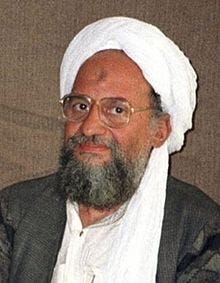In this 20-minute interview, Hollie McKay talks about Al Qaeda terrorist leader Ayman al-Zawahiri, whom the US killed in a CIA drone strike in Kabul, Afghanistan on July 31st at the home of a senior official of the Taliban government’s Haqqani Network faction.
About where Zawahiri came from, Hollie says,
Al Zawahiri is somebody that I've looked into a lot over the over the years. At the beginning of 2019, I spent a lot of time in Afghanistan, Pakistan, sort of in the area trying to kind of piece together whatever I could about him and his whereabouts. At that point, he was the number two Al Qaeda leader. There was a $25 million US. Bounty was on his head. He was right in there under Osama bin Laden. When Osama was killed, he took the reins as the as the top leader. I think it's important to go back and take in a little bit of background about him.
He was always kind of framed as being a more wiser alternative to al-Baghdadi, who at that point was leading ISIS. Zawahiri himself characterized ISIS as naive and irresponsible. Zawahiri was this older guy. I think at that point he was around 67, so he would have been in his early 70s and at this point when he was killed.
He went under a number of different pseudonyms. He was Abu Mohammed. He was called the Doctor. He was the Teacher, and he was Abdel Nour. He was actually an eye surgeon. He was always known to wear these white turbans. He got his start as a teenage member of Cairo's Muslim Brotherhood. He was an Egyptian. He formed his own underground cell that was devoted to establishing an Islamic State called the Egyptian Islamic Jihad before he went on to medical school.
After that, Zawahiri went on to climb the terrorist ranks. In his early 30s, after a religious visit to Saudi Arabia in 1985, and that's where he merged his own cell with Osama bin Laden's Fighting Fleet. He became Osama’s personal physician and advisor around 1986. In 1993, he was reported to have even traveled to California to raise money for Afghan children wounded in the war with the Soviets.
In the ensuing years, Zawahiri ordered attacks, including the 1995 bombing of the Egyptian embassy in Islamabad and he played a prominent part in a coordinated series of 1998 U.S. embassy explosions in East Africa. As a terrorist, he certainly has a quite a track record.
Then what we saw in 2013 was the rise of ISIS. That really came following a split by ISIS from Al Qaeda and Zawahiri
He really came out to denounce the rival organization. That was in reality a strategic bid not to alienate vast segments of the population who were looking for that extremism but still opposed to the ISIS movement.
While Baghdadi, at that point, was fairly camera shy and rarely ever appeared in in videos or even voice recordings, Zawahiri has quite frequently visible, although less in recent years, featured on the propaganda screen; again, playing that wise role and releasing different videos with audio footage playing special tributes.
About Zawahiri’s relationship with the Haqqani Network, Hollie notes,
Zawahiri often played a prominent tribute to the Haqqani's; and when one of these Haqqani leaders would die, Zawahiri would often release a tribute video. Fast forward and look at Afghanistan, which a year ago, fell to the Taliban. And of course, a major leader within the Taliban, and one of the top security directors of the country is, Siraj Haqqani.
On the hunt for al-Zawahiri over the years, Hollie chronicles,
I remember in 2014 Zawahiri called for the return of Al Qaeda in India. It was always just very unclear where he was hiding out and that was something that I was really looking into at the time and the intelligence on his location at that point in 2019 was really varied.
In early 2017, they had some very good sources in the US that said Pakistan was the likely sanctuary, which of course at that point in the federally administered tribal areas, there were a lot terrorists hiding out.
A little bit later a couple of years later, more in sort of 2019 intelligence operatives, both in the United States and sort of in the Middle East had pinpointed his location to those ungoverned spaces between Pakistan and Afghanistan. It wasn't quite clear, but those areas tend to be where people cross those borders fairly freely. It was very unclear. He was possibly in the Waziristan region where there were numerous reports of his sightings. I think that there were some reports that he was even captured, but they were generally considered to be false alarms. I also do remember in early 2016 the US conducted a drone strike on a confirmed Zawahiri location at that point, which was North Gilgit-Baltistan’s Shallow valley in Pakistan; but apparently, he managed to escape so. I think a decade earlier the US was also reported to have launched an airstrike on the Pakistani border in a village called Dam Adola, Pakistan which was near Afghanistan.
On the existence of Al Qaeda in Afghanistan,
Recall that in August, 2021 episode about 20 terrorist groups still operating in Afghanistan appeared in this substack,
What I was told from very good sources connected to both Al Qaeda and the Haqqani when I was living in Afghanistan last year was essentially that al Qaeda did exist. I was told, there were certainly people that were loyal to Zawahiri, loyal to al Qaeda, that were still in Afghanistan.
They were under extremely strict orders and conditions that they could absolutely do no military action and any evidence of them, planning, plotting, trying to, you know, do anything militarily would result in them being punished or killed.
That directive I assume still stood and is unclear that if Zawahiri and what exactly he was doing, how military it was, and it's also unclear how much of the Taliban leadership knew he was there.
My impressions from sources within those networks were that they knew that they were there, that they were living freely in Afghanistan after that fall, but were basically essentially under some sort of sort of house arrest where couldn't actually act upon anything that would violate the Doha agreement with the United States that in exchange for the US completely leaving the country , the Taliban would not harbor or enable any terrorist organizations to plot anything against the US.
In its interesting, however, the Doha Agreement was careful, my interpretation of it, didn't say that these organizations couldn't exist in Afghanistan, they just said that they couldn't plot attacks against the US or its allies and interests.
The Taliban have come out with a statement decrying the drone strike over the weekend.
Please listen the complete interview.
Please follow and support my investigative/adventure/war zone work for LIBERTY DISPATCHES here: https://dispatch.libertyblockchain.com/author/holliemckay/
For speaking enquires please contact meta@metaspeakers.org
For those interested in learning more about the aftermath of war, please pick up a copy of my latest book “Only Cry for the Living: Memos from Inside the ISIS Battlefield.”
If you want to support small businesses:















Share this post